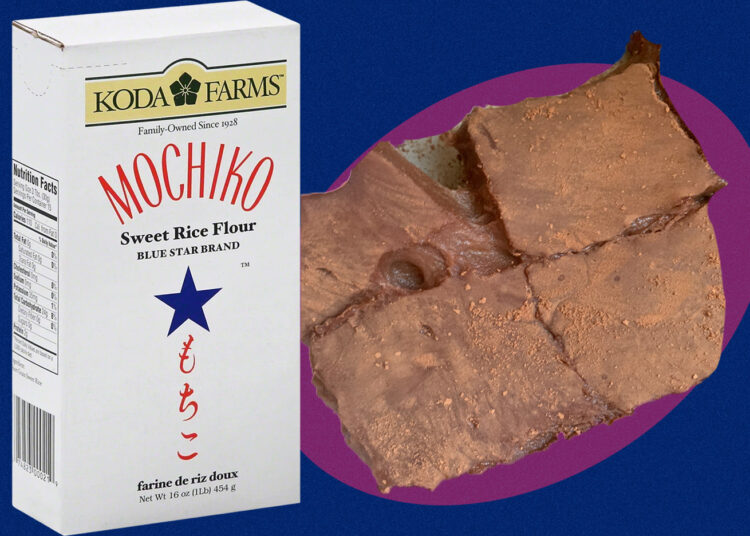Photo illustration by Lille Allen; see below for full credits.
All you need is cocoa powder, mochiko flour, sugar, a microwave, and some grit
Everyone knows me for my butter mochi. It’s been my go-to potluck dish for over a decade, ever since I learned how to make it from a college friend who was born and raised in Hawai’i. The wonderful thing about butter mochi is how easy it is — both to make and to eat. It’s gluten-free, so it’s impossible to overmix (you can even make the batter in a blender) and accessible for people with dietary restrictions. The mochi itself is easy to divide and the texture is pleasantly bouncy. And the sweet rice flour is an adaptable vehicle for flavor — Thai tea, pandan, ube, and black sesame are just a handful of the butter mochis I’ve made in the past.
When I make butter mochi, I always pick up a box of Koda Farms’s mochiko, or sweet rice flour. Recently, I noticed there’s a recipe for chocolate mochi — not butter mochi — on the box. Where butter mochi requires cans of coconut and evaporated milk and a solid hour in the oven, this chocolate mochi recipe only needs to be zapped in a microwave for five to 10 minutes. Beyond the cooking method, the recipe requires a mere three ingredients (four if you include water).
It seemed way too easy. I was picturing the outcome before I even started: pillowy, cartoon-like squares of cocoa-dusted mochi with impeccable chew and a balance of bitter and sweet chocolate flavor that would transport me straight to Japan. What I got instead was a kitchen that looked like a set piece for a Ghostbusters movie covered in ectoplasmic goo.
The recipe begins simply enough: You make a chocolate syrup with cocoa powder, water, and sugar, heated on the stove.
From there, I can admit to some user error. Since my metal mixing bowls can’t go in the microwave, I instead opted to mix the mochiko flour and water in a large glass pie pan. Although this can be done, it was definitely difficult to whisk without spillage. Once the sticky rice flour paste formed, I covered it and put it in the microwave for five minutes as instructed.
The first time the pie pan came out of the microwave, it was perfectly fine. Yes, it was at absolute capacity, but the mochiko paste was steaming and heated through. All it needed at that point was another good stir and then an additional five minutes in the microwave, covered once more.
This is where everything went south. Again, I am mostly to blame for using such a shallow dish and I should have been checking on the mochi throughout its additional time in the microwave. If I had, I would have seen the mochi paste bubble over like sticky lava, coating the bottom of my microwave in stringy, molten webs. I think I lost a quarter cup of the paste this way, which affected the finished dish. To add (literal) injury to insult, I burned my fingertips when I attempted to save the bubbling, overflowing mochi paste.
Once it was out of the microwave, I decided to place the batter into one of my larger mixing bowls because at that stage the chocolate syrup needed to be folded in and the pan simply did not have enough room to do that. This meant another dirty, sticky dish I’d have to wash later.
The paste, once heated, is very thick. It is an arm workout to whisk the chocolate syrup into it; I could feel my shoulder muscle pulsating. Because I lost mochi paste along the way, the resulting mochi batter mixed with chocolate syrup seemed runnier than it was meant to be. My thinking was that it just needed time to cool and firm up, so I poured the batter into an oiled 9-by-13-inch pan, coated the top with a thin dusting of cocoa powder, and hoped for the best.
The finished mochi was woefully sticky. It was difficult to cut into even squares even after oiling my knife, rendering each portion into a shapeless brown blob. It’s still pleasant to eat — the flavor is lightly sweet and chocolaty with a subtle bitterness and a fun, chewy texture — but the sensorial nightmare of getting your fingertips coated with mochi goo any time you reach for a bite knocks some of the pleasure out of it. Sure, I could have eaten it with chopsticks or a fork, but that’d be an additional thing to wash, so I just ended up powering through and coping with my sticky hands. Either way, I think I’ll be sticking with butter mochi moving forward.
Additional photo illustration credits: Kat Thompson














